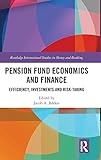Pension Fund Economics and Finance: Efficiency, Investments and Risk-Taking
Publication details: Routledge, New York, 2018.Description: xv, 256 pages; illustrations: 24 cmISBN:- 9781138656802
- 332.67254
| Item type | Current library | Collection | Call number | Status | Date due | Barcode | |
|---|---|---|---|---|---|---|---|
 Book
Book
|
Indian Institute of Management Visakhapatnam General Stacks | Reference | 332.67254 BIK (Browse shelf(Opens below)) | Not For Loan | 001075 |
Browsing Indian Institute of Management Visakhapatnam shelves, Shelving location: General Stacks, Collection: Reference Close shelf browser (Hides shelf browser)

|

|

|

|

|

|

|
||
| 332.0414 FAB Capital markets : | 332.46 WAL Monetary theory and policy / | 332.6019 ECO Handbook of investors' behavior during financial crises / | 332.67254 BIK Pension Fund Economics and Finance: Efficiency, Investments and Risk-Taking | 338.04 DUE Entrepreneurial identity: | 338.04 HAL Measuring entrepreneurial business: current knowledge and challenges | 338.04072 WEL A research agenda for entrepreneurship and context / |
Introduction
A scale-economy
The impact of scale complexity and service quality on
Cost differences between pension funds and life insurers
Implications for longterm
Pension fund investment policy risktaking ageing
Investor sophistication and risktaking
Investment risktaking by institutional investors
Measuring and explaining implicit risk sharing in defined
Utilityequivalence of pension security mechanisms
Copyright
Pension fund benefits are crucial for pensioners’ welfare and pension fund savings have accumulated to huge amounts, covering a major part of world-wide institutional investments. However, the literature on pension fund economics and finance is rather limited, caused, in part, to limited data availability. This book contributes to this literature and focuses on three important areas. The first is pension fund (in)efficiency, which has a huge impact on final benefits, particularly when annual spoilage accumulates over a lifetime. Scale economies, pension plans complexity and alternative pension saving plans are important issues.
The second area is investment behavior and risk-taking. A key question refers to the allocation of investments over high risk/high return and relatively safe assets. Bikker investigates whether pension funds follow the life-cycle hypothesis: more risk and return for pension funds with young participants. Many pension funds are rather limited in size, which may raise the question how financially sophisticated the pension fund decision makers are: rather professionals or closer to unskilled private persons?
The third field concerns two regulation issues. How do pension fund respond to shocks such as unexpected investment returns or changes in life expectancy? What are the welfare implications to the beneficiary for different methods of securing pension funding: solvency requirements, a pension guarantee fund, or sponsor support?
This groundbreaking book will challenge the way pension fund economics is thought about and practiced.
There are no comments on this title.

